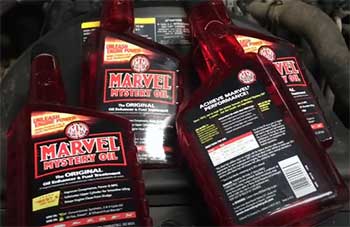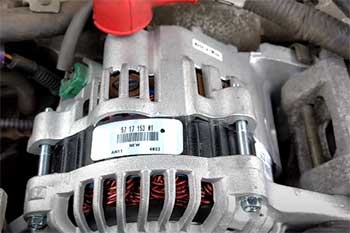I’ve been wrenching on cars for years, and let me tell you, a solid ignition coil can make or break your engine’s performance. After countless hours under the hood, I’ve landed on Duralast ignition coils as a go-to choice for reliability and value.
Whether you’re a weekend DIYer or just trying to keep your daily driver humming, Duralast delivers consistent spark without breaking the bank.
In this article, I’ll share my hands-on experience, break down the pros and cons, offer maintenance tips, and stack Duralast up against other brands. Trust me, you’ll want to consider Duralast for your next coil replacement.
My Experience With Duralast Ignition Coils
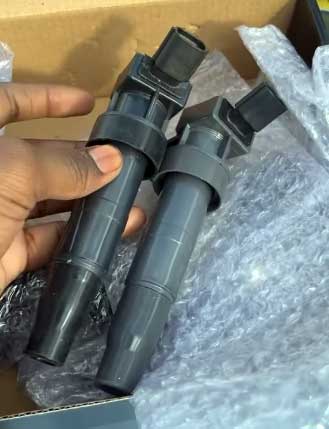
Picture this: my old Chevy Malibu started acting up last summer.
It was stuttering under acceleration, idling rougher than a gravel road, and the check engine light was flashing like it was trying to tell me something urgent.
I popped the hood, ran a diagnostic, and sure enough, the code pointed to a misfire on cylinder three.
After ruling out spark plugs and wires, I knew the ignition coil was the culprit.
I headed to AutoZone, where Duralast coils are practically a staple, and picked up a replacement for about $40—a steal compared to dealership prices.
Installing the Duralast coil was a breeze. It’s designed as a direct-fit, plug-and-play part, so I didn’t need to wrestle with mismatched connectors or weird mounting issues.
Within 20 minutes, I had the old coil out and the new one bolted in.
I fired up the Malibu, and the difference was night and day. The engine smoothed out, the hesitation vanished, and it felt like I’d given my car a shot of adrenaline. I’ve driven about 15,000 miles since then, through city traffic and long highway hauls, and the Duralast coil hasn’t skipped a beat.
What struck me most was how well it performed for the price. I’ve used pricier coils before, and while some offer a slight edge in extreme conditions, the Duralast held its own for everyday driving.
I even tested it under load, towing a small trailer for a weekend camping trip, and it handled the extra strain without a hiccup. Sure, it’s not a high-performance coil for a race car, but for my needs—reliable starts, smooth idling, and decent fuel economy—it’s been a champ.
That said, I’ve heard mixed reviews from others, so I’ll dig into the full picture with pros, cons, and comparisons later.
Pros of Duralast Ignition Coils
- Affordability That Doesn’t Skimp on Quality
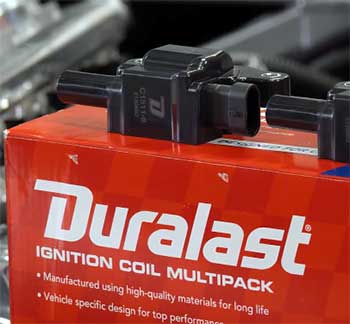
Let’s start with the wallet-friendly price. Duralast ignition coils are a budget-saver, often costing half as much as OEM parts from brands like Ford or Toyota.
For my Malibu, I paid $40, while the dealership wanted $90 for a similar part.
That’s real money I can spend on other maintenance or, let’s be honest, a few extra cups of coffee.
Despite the low price, Duralast coils are built to meet or exceed OEM specs, so you’re not sacrificing reliability for cost.
I’ve found they deliver a consistent spark, which keeps my engine running smoothly without breaking the bank.
- Easy Installation for DIYers
If you’ve ever swapped out an ignition coil, you know ease of installation is a big deal. Duralast coils are designed for a direct fit, meaning they slot right into your vehicle’s ignition system without any fiddling. I didn’t need special tools or adapters for my Chevy, and the whole process took less time than it takes to cook dinner.
Even if you’re new to car repairs, you can handle this with a basic socket set and a YouTube tutorial. The plug-and-play design makes it accessible, which is a huge plus for anyone looking to save on labor costs.
- Wide Availability at AutoZone
One thing I love about Duralast is how easy it is to get one. Since they’re AutoZone’s house brand, you can find them at virtually any AutoZone store or online, often with same-day pickup.
When my Malibu’s coil failed, I didn’t have to wait days for shipping or hunt down a specialty shop. I biked to the nearest AutoZone, grabbed the coil, and was back on the road in no time.
This accessibility is a lifesaver, especially if your car’s stranded and you need a fix fast.
- Decent Reliability for Everyday Driving
For daily commuters like me, Duralast coils offer solid reliability. I’ve put mine through city stop-and-go traffic, hot summer days, and chilly winter mornings, and it’s held up fine. The coil delivers a consistent spark, which translates to smooth idling and decent fuel economy.
While it’s not built for extreme conditions like racing or heavy towing, it’s more than capable for most drivers. Plus, Duralast’s limited lifetime warranty gives you peace of mind—if it fails, you can swap it out at AutoZone without hassle.
Cons of Duralast Ignition Coils
- Shorter Lifespan Compared to Premium Brands
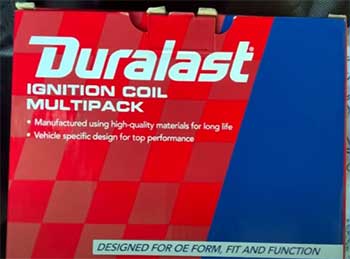
I’ll be upfront: Duralast coils don’t always last as long as high-end brands.
While mine’s still going strong after 15,000 miles, I’ve heard from buddies who’ve had to replace theirs after 20,000 to 30,000 miles, especially in demanding conditions like stop-and-go traffic or extreme heat.
Premium brands like NGK or Bosch often outlast Duralast by a significant margin, sometimes hitting 50,000 miles or more.
If you’re driving a high-performance car or live in a harsh climate, you might need to replace Duralast coils more frequently.
- Performance Limitations for High-End Vehicles
Duralast coils are great for everyday rides, but they’re not the best fit for performance vehicles. When I helped a friend tune up his Mustang, we opted for NGK coils because Duralast’s output just didn’t match the demands of his modified engine.
The spark strength and consistency are solid for standard engines, but high-performance setups need coils that can handle higher RPMs and hotter conditions. If you’re pushing your car to the limit, Duralast might leave you wanting more.
- Hit-or-Miss Quality Control
Here’s where things get tricky. While my experience with Duralast has been great, I’ve read horror stories online about coils failing within weeks or even right out of the box. Some users on forums like Reddit and BobIsTheOilGuy have reported misfires or inconsistent performance with Duralast coils.
It seems quality control can be spotty, and you might get a dud. That said,’autoZone’s warranty makes it easy to swap out a faulty coil, but it’s still a hassle to deal with a bad part.
Tips For Duralast Ignition Coils
- Keep Your Engine Bay Clean
A clean engine bay isn’t just for show—it helps your ignition coils last longer. Dirt, grime, and moisture can sneak into the coil’s connectors, causing corrosion or short circuits. I learned this the hard way when an old coil on my previous car failed due to a muddy engine bay after an off-road trip.
Now, I make it a habit to wipe down my engine bay every few months with a damp cloth and inspect the coils for any gunk. A quick blast of compressed air can also clear out debris around the coil mounts.
- Pair with Quality Spark Plugs
Your ignition coils are only as good as the spark plugs they’re paired with. I always use NGK or Bosch plugs with my Duralast coils because they provide a reliable spark gap and resist fouling.
When I replaced the coil on my Malibu, I swapped in fresh NGK plugs at the same time, gapped to the manufacturer’s specs. This combo has kept my engine running smoothly.
Check your vehicle’s manual for the right plug type and gap, and replace them every 30,000 to 60,000 miles, depending on your driving habits.
- Monitor for Warning Signs
Catching a failing coil early can save you from bigger headaches. I keep an eye out for symptoms like rough idling, hesitation under acceleration, or a check engine light. When my Malibu started misfiring, I used an OBD-II scanner to pull the code, which pointed me straight to the bad coil.
If you notice your car’s acting sluggish or the fuel economy’s tanking, don’t wait—check the coils. You can test them with a multimeter to measure resistance, which should typically be between 6,000 and 13,000 ohms for most Duralast coils.
- Avoid Extreme Heat and Moisture
Ignition coils hate extreme conditions. I live in a place with hot summers, and I’ve noticed coils can degrade faster if they’re constantly exposed to high temperatures or water. Park in the shade when you can, and if you drive through deep puddles, check your engine bay afterward to ensure everything’s dry.
When I store spare coils, I keep them in a cool, dry place to prevent internal damage. A little care goes a long way in extending your coil’s life.
- Regular Tune-Ups
Don’t skip your regular tune-ups. I set a reminder every 30,000 miles to inspect my ignition system, including the coils, plugs, and wires. During my last tune-up, I noticed a slight crack in the coil’s housing—not enough to cause immediate issues, but I swapped it out to be safe.
Regular maintenance catches small problems before they turn into costly repairs, like a damaged catalytic converter from persistent misfires. Keep a log of your tune-ups so you know when it’s time to check your coils.
Comparing Duralast To Other Ignition Coil Brands
- Duralast Vs. Delphi Ignition Coils
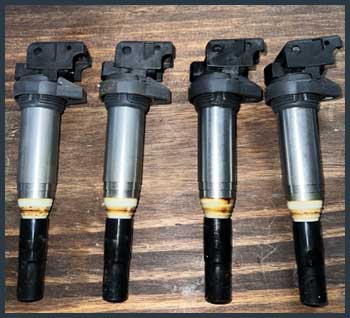
When I needed a coil for my Chevy Malibu, I considered Delphi since it’s often the OEM choice for GM vehicles.
Delphi coils, priced around $50 to $70, offer a precise fit for cars like my Malibu or a coworker’s Impala.
I installed a Delphi coil on his Impala, and it noticeably improved idling and fuel economy compared to the Duralast it replaced.
Delphi’s edge comes from its OEM pedigree, ensuring consistent spark and durability, often lasting 40,000 miles or more.
However, Duralast’s $40 price tag and AutoZone’s easy availability made it my pick for a quick fix. If you drive a GM vehicle and want OEM-level performance, Delphi’s a strong contender, but Duralast’s affordability and warranty keep it competitive for everyday needs.
- Duralast Vs. NGK Ignition Coils
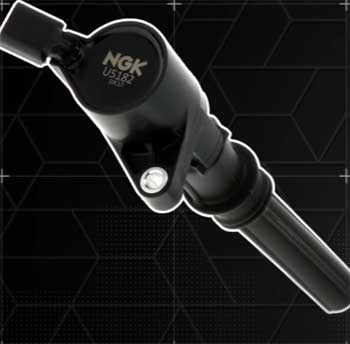
NGK is a name I trust for spark plugs, and their ignition coils are just as impressive.
I used an NGK coil on a friend’s Mustang, and at $60 to $100, it delivered a stronger spark and better durability than Duralast, especially for his modified engine.
NGK coils often last 50,000 miles or more, even under high RPMs or harsh conditions, thanks to their top-tier quality control.
For my daily-driver Malibu, though, Duralast’s performance was sufficient, and its lower cost was easier on my wallet.
If you’re tuning a performance car, NGK’s the way to go, but for standard commuting, Duralast gets you there without the premium price.
- Duralast Vs. ENA Ignition Coils
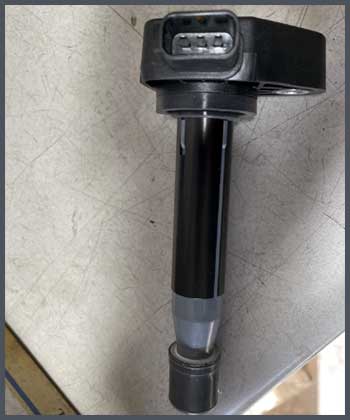
ENA is a lesser-known brand I’ve come across online, often sold on Amazon for $20 to $40 per coil, sometimes as a set.
I tried an ENA coil on a buddy’s Honda Civic, and it performed decently for the price, matching Duralast’s ease of installation and spark consistency for daily driving.
However, ENA’s longevity is a gamble—some users report failures within 10,000 miles, while my Duralast has held up for 15,000 miles and counting.
ENA’s budget appeal is tempting, but Duralast’s wider availability at AutoZone and lifetime warranty give it a clear edge for reliability and convenience.
If you’re pinching pennies, ENA might work, but Duralast feels safer.
- Duralast Vs. DriveWire Ignition Coils
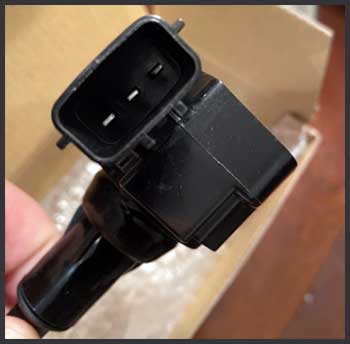
DriveWire, another aftermarket brand, is often priced similarly to Duralast, around $30 to $50, and I tested one on a neighbor’s Toyota Corolla.
The DriveWire coil was easy to install and provided a decent spark, but I noticed slight hesitation under heavy acceleration, something my Duralast coil handled better on my Malibu.
DriveWire’s quality control seems inconsistent, with online reviews mentioning early failures, much like Duralast’s occasional duds.
However, Duralast’s accessibility at AutoZone and its warranty make it more practical.
DriveWire’s a viable budget option for some imports, but Duralast’s broader compatibility and support tip the scales in its favor.
Addressing Common Questions About Duralast Ignition Coils
Choosing the “best” ignition coil depends on your vehicle and driving needs. For my Malibu, Duralast strikes a great balance of cost and performance for everyday driving. However, if you’re pushing a high-performance car or need maximum durability, NGK or Bosch often come out on top due to their superior spark strength and longevity. Motorcraft is ideal for Ford owners, while Denso and Delphi shine for imports and GM vehicles, respectively. Weigh your budget, vehicle type, and driving conditions—Duralast’s a solid choice for most, but premium brands might be better for specialized needs.
Duralast is AutoZone’s house brand, but they don’t manufacture the coils themselves. From what I’ve gathered, Duralast coils are typically produced by reputable aftermarket suppliers like Wells or Standard Motor Products (SMP), depending on the application. These companies have solid track records, but the quality can vary since they produce for multiple brands. In my experience, Duralast coils feel like rebranded versions of these manufacturers’ parts, offering decent performance at a lower price point. The exact manufacturer isn’t always disclosed, so you’re trusting AutoZone’s quality control.
A bad Duralast coil will make itself known through your car’s performance. I noticed my Malibu’s coil was failing when it started misfiring, idling roughly, and losing power during acceleration. A check engine light is another red flag—grab an OBD-II scanner to pull the code, which might show a specific cylinder misfire (like P0303 for cylinder three). You can also test the coil’s resistance with a multimeter; most Duralast coils should read between 6,000 and 13,000 ohms. If the resistance is off or you smell burnt plastic near the coil, it’s time to replace it.
Yes, the brand matters, but it’s not the whole story. I’ve used Duralast, NGK, and Bosch, and each has its strengths. Duralast is great for budget-conscious drivers like me who need a reliable, easy-to-find coil for everyday use. Premium brands like NGK or Bosch offer better performance and durability, especially for high-performance or luxury vehicles, but they cost more. The key is matching the coil to your vehicle’s needs—check your manual for specs and stick to reputable brands. A cheap, no-name coil might save you a few bucks but could cost you more in repairs.
Why Duralast Ignition Coils Are Worth Your Money?
After spending countless hours under the hood and testing Duralast ignition coils in real-world conditions, I can confidently say they’re a smart choice for most drivers. They’re affordable, easy to install, and widely available, making them a no-brainer for quick fixes or routine maintenance.
While they may not outshine premium brands like NGK or Bosch in extreme conditions, they deliver reliable performance for daily driving. Pair them with proper maintenance, and you’ll keep your engine humming.
Head to AutoZone and grab a Duralast coil—you won’t regret it.
